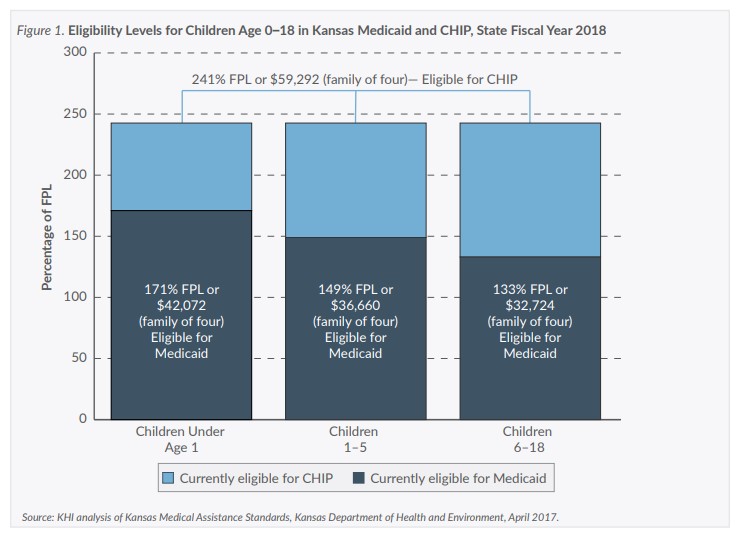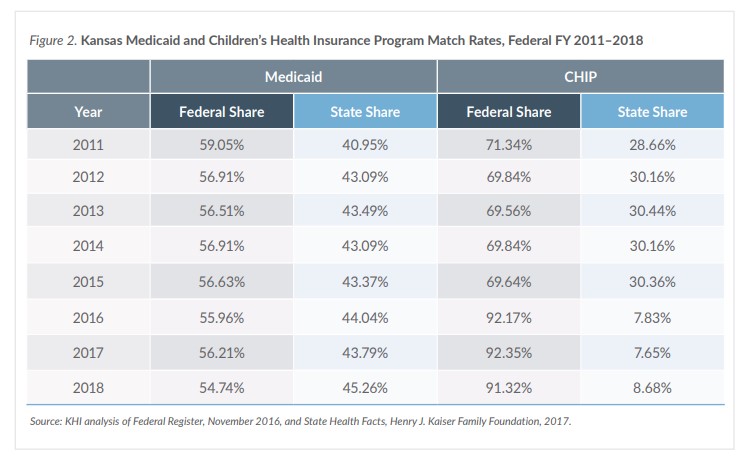The budget adopted by the Kansas Legislature in June 2017 assumed the ACA-enhanced match rate would continue. Of the $114.5 million appropriated by the Legislature for CHIP in state FY 2018, just $8.9 million was appropriated from state funds.
The Senate deal would preserve that enhanced rate through the end of federal FY 2019 and would not require additional state appropriations. Reportedly, the Senate deal would cut the 23-percent enhancement in half in federal FY 2020, and the CHIP match rate would return to pre-ACA levels in federal FY 2021.
Under the current Kansas CHIP budget, every 1 percent of federal match represents about $1.15 million, so reducing the CHIP federal match rate by 11.5 percent would require about $13.2 million in additional state funding.
What if Congress does not extend CHIP?
If the reauthorization deal falters in either the Senate or the House, CHIP funding could still expire. If so—or if an alternative plan passes that more immediately revises the funding structure for the program—some states have options for responding to these changes.
Under the ACA, states that cover CHIP through their Medicaid programs must maintain their programs through 2019, regardless of what happens to federal funding. However, Kansas is among states that have what is called a “separate” CHIP program, meaning it has distinct authority. States with separate programs are technically covered by the same maintenance-of effort requirement through 2019, but in the case of a federal funding shortfall, there are exceptions that effectively permit the termination of separate CHIP programs.
Kansas also has what is called an “M-CHIP” enrollment group—children who are eligible for Medicaid who would have been eligible for CHIP before the ACA. In Kansas, this group is children age 6–18 with household incomes between 113 and 133 percent of FPL. States receive the CHIP match rate for M-CHIP children, but because they are Medicaid enrollees, the maintenance-of-effort requirement applies to M-CHIP regardless of federal funding levels for CHIP.
There are options for states with separate CHIP programs if funding is not reauthorized.
Option 1: States may choose to wait until closer to when their funds expire to act.
Even if CHIP is not immediately reauthorized, states can use unexpended and redistributed “carryover” funds from previous years. The Medicaid and CHIP Payment and Access Commission (MACPAC) estimates that Kansas will have $47.7 million in carryover funds available in federal FY 2018, which MACPAC estimates would last through the end of March 2018.
Option 2: States may decide to terminate their CHIP programs and transition children to other coverage options.
States with separate CHIP programs could elect to transition some CHIP enrollees to their Medicaid program by expanding eligibility for children, or they could set up a process to transition children on CHIP to the health insurance marketplace created by the ACA.
Many children currently enrolled in CHIP are in households that could be eligible for subsidized health insurance plans on the marketplace. In states where the federal government manages the marketplace, as in Kansas, families would have to be notified that they would need to apply at the marketplace after their children’s information was transferred to the federal government by the state.
Even then, some children might fall into what is called the “family glitch,” when a parent is offered employment-based health insurance that is considered affordable for a single person, but not affordable for the entire family. In this case, the family members would not qualify for subsidies on the health insurance marketplace.
In addition, for some children in households that would qualify for subsidies, the higher costs associated with marketplace plans might be a disincentive for enrollment. Kansas charges modest monthly premiums for some CHIP-enrolled children, and there are no copays in KanCare, the state’s managed care program for Medicaid and CHIP. On the marketplace, premiums for silver plans, which are the only plans eligible for cost-sharing reductions on out-of-pocket costs, likely would cost families more than CHIP, even after tax credits.
Option 3: States could impose enrollment caps.
Federal law allows states with separate CHIP programs to implement other policies to attempt to extend available funding, including establishing enrollment caps. Kansas law, however, does not allow waiting lists for CHIP, instead giving the Kansas Department of Health and Environment (KDHE) authority to reduce CHIP eligibility levels based on the availability of federal funding. If CHIP funding is not reauthorized, the Legislature could act to allow enrollment caps and waiting lists before the carryover funds expired. However, if the MACPAC estimate of when Kansas’ funds would be exhausted were correct, the option might not be feasible in Kansas.
Conclusion
If Congress fails to reauthorize CHIP before the September 30 deadline, Kansas policymakers could be forced to make difficult decisions that would affect the state budget and thousands of Kansas families. It is important that policymakers know their options so they will be prepared to act quickly, if needed, to provide new coverage options for approximately 38,000 low-income children currently enrolled in CHIP.



